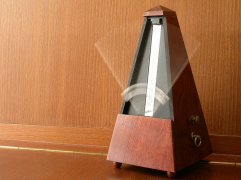György Ligeti; A Sonic Explorer of the Avant-Garde
(1923-2006)
By Jo Ann Vick
György Sándor Ligeti, a Hungarian composer born on May 28, 1923, in Dicsoszentmárton (now Târnaveni, Romania), emerged as one of the most innovative and influential composers of the 20th century. Ligeti's works traversed various musical landscapes, ranging from avant-garde compositions to orchestral masterpieces, earning him acclaim for his unique approach to sound and form.
Early Life and Musical Education
Growing up in a multicultural region, Ligeti experienced a blend of Hungarian, Romanian, and Saxon cultures. His exposure to this rich cultural tapestry, along with the tumultuous political climate of World War II, significantly shaped his artistic sensibilities. Ligeti's early interest in music led him to study at the Franz Liszt Academy of Music in Budapest, where he encountered the works of Bartók and Kodály, composers who would influence his later compositions.Escape from Totalitarianism
The post-war period in Hungary was marked by the oppressive rule of the Soviet Union. Ligeti, along with many other artists and intellectuals, faced censorship and political pressure. In 1956, during the Hungarian Uprising, Ligeti seized the opportunity to escape the totalitarian regime, fleeing to Vienna. This escape marked a turning point in his life, freeing him to explore and experiment with his musical ideas without the constraints of political censorship.Early Compositions: Micropolyphony and Atmospheres
Ligeti's early compositions were characterized by his fascination with texture, sound masses, and innovative use of polyphony. One of his groundbreaking works from this period is "Apparitions" (1958-1959), which employed micropolyphony, a technique where individual lines blur into a complex, densely woven texture. This piece marked Ligeti's departure from traditional harmonic structures, embracing a more avant-garde and experimental approach.His orchestral work "Atmosphères" (1961) further exemplified Ligeti's exploration of sound color and texture. Eschewing traditional melody and harmony, the piece is a sonic tapestry where different instrumental groups contribute to an ever-shifting, otherworldly atmosphere. "Atmosphères" gained international recognition and became a landmark composition in the realm of avant-garde music.
Reimagining the Human Voice: Aventures and Nouvelles Aventures
Ligeti's exploration extended beyond instrumental music. In "Aventures" (1962) and "Nouvelles Aventures" (1962-1965), he delved into the realm of vocal experimentation. These works, characterized as "anti-operas," showcased Ligeti's interest in deconstructing conventional vocal techniques. The vocalists in these compositions engage in non-traditional vocalizations, including laughter, murmurs, and vocal noises, challenging the boundaries of what was considered acceptable in vocal music.Mechanical Music and Poème Symphonique
In the mid-1960s, Ligeti explored the concept of mechanical music, incorporating elements of chance and unpredictability into his compositions. One of the most notable examples of this period is "Poème Symphonique for 100 Metronomes" (1962). In this piece, each metronome is set to a different tempo, creating a gradually evolving sonic landscape. The performance involves a degree of unpredictability, as the metronomes wind down at different rates, reflecting Ligeti's interest in introducing an element of randomness into music.Transformation and Innovation: Requiem and Lux Aeterna
Ligeti's compositional style evolved over time, and in the late 1960s, he embraced a more accessible and tonal language while retaining his commitment to innovation. The "Requiem" (1963-1965) and "Lux Aeterna" (1966) showcased this shift. While still exploring unconventional vocal techniques, these compositions introduced elements of tonality and harmony, offering a bridge between Ligeti's avant-garde roots and a more approachable musical language.Space Odyssey 2001: "Lux Aeterna" in Film
Ligeti gained international recognition when excerpts from "Lux Aeterna" were used in Stanley Kubrick's landmark film "2001: A Space Odyssey" (1968). The ethereal and haunting quality of Ligeti's music, combined with the film's striking visuals, created an iconic cinematic experience. This exposure introduced Ligeti's work to a broader audience and solidified his reputation as a composer with a unique sonic palette.Later Works: Chamber Concerto, Horn Trio, and Piano Etudes
In the following decades, Ligeti continued to produce a diverse array of compositions. His "Chamber Concerto" (1969-1970) showcased his interest in textures and timbres, while the "Horn Trio" (1982-1983) demonstrated his ability to blend traditional forms with modern sensibilities. Ligeti's "Études for Piano" (1985-2001) further exemplified his technical prowess and creativity, exploring new possibilities for the instrument.Legacy and Honors
György Ligeti's contributions to contemporary classical music have left an enduring legacy. His innovative use of texture, polyphony, and vocal techniques expanded the possibilities of what music could convey. Ligeti received numerous accolades throughout his career, including the prestigious Grawemeyer Award for Music Composition in 1986 and the Polar Music Prize in 2004.György Ligeti, a sonic explorer of the avant-garde, pushed the boundaries of classical music with his groundbreaking compositions. From the experimental micropolyphony of his early works to the accessible yet innovative later compositions, Ligeti's career was marked by a relentless pursuit of new sounds and musical ideas. His influence on contemporary classical music is immeasurable, and his works continue to be studied, performed, and appreciated for their visionary approach to the art of sound. György Ligeti's legacy resonates not only in concert halls but also in the broader cultural landscape, where his contributions have had a lasting impact on the evolution of music in the 20th century and beyond.
Jo Ann Vick is a private piano instructor with 20 years of training and performing experience
and has a home based studio in Frisco, Texas. Her mission is to develop in others, a love
for playing the piano. Her website is located at www.teachmethepiano.com




